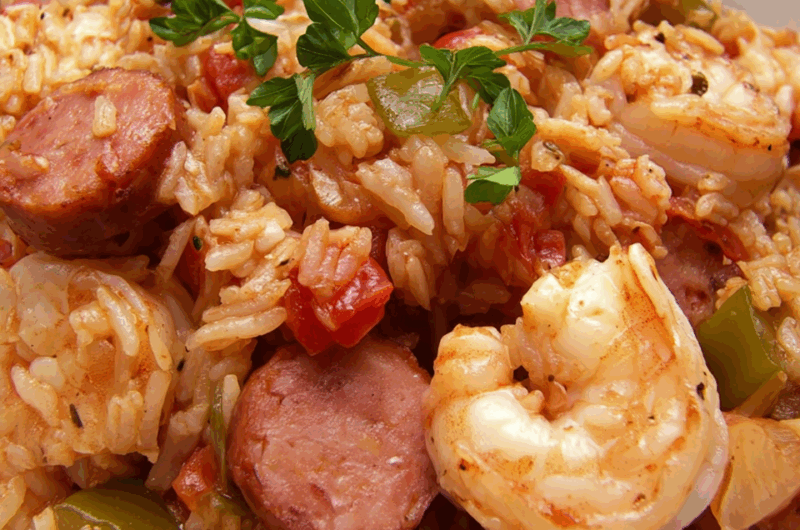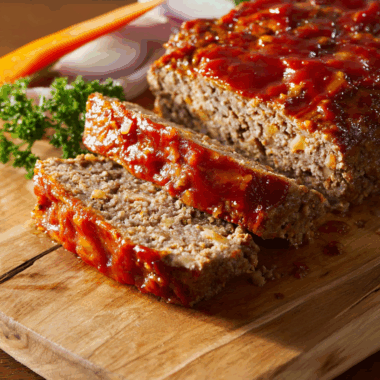The heart and soul of Louisiana cuisine come alive in this mouthwatering jambalaya dish. Combining smoky sausage, succulent shrimp, tender vegetables, and perfectly seasoned rice, Cindy’s Jambalaya is a one-pot wonder that delivers on flavor and simplicity. Whether you’re cooking for your family or impressing guests, this recipe brings bold Cajun spices and comforting textures together in every bite.
You’ll love how easy this meal is to prepare with ingredients that are both affordable and accessible. It’s a dish that invites creativity—swap out proteins, amp up the heat, or even throw in extra veggies. From busy weeknights to lazy Sundays, this Southern classic is the kind of recipe that feels like home with every spoonful.
Full Recipe:
-
2 tablespoons olive oil
-
1 pound smoked sausage, sliced
-
1 large onion, chopped
-
1 green bell pepper, chopped
-
2 stalks celery, chopped
-
1 teaspoon salt (or to taste)
-
1 tablespoon Cajun seasoning
-
1 1/2 cups long grain white rice
-
1 (14.5 ounce) can diced tomatoes with juice
-
2 cloves garlic, minced
-
3 cups chicken broth
-
2 bay leaves
-
1 teaspoon fresh thyme leaves (or 1/2 teaspoon dried)
-
1 pound raw shrimp, peeled and deveined
Directions:
-
In a large Dutch oven or deep pot, heat olive oil over medium heat.
-
Add sliced sausage and sauté for about 2 minutes.
-
Add onion, bell pepper, and celery. Sprinkle with salt and Cajun seasoning. Cook for 6–8 minutes or until vegetables are softened.
-
Stir in the uncooked rice, allowing it to toast slightly for 1–2 minutes.
-
Add diced tomatoes (with juice), minced garlic, chicken broth, bay leaves, and thyme. Stir well.
-
Bring mixture to a simmer over medium-high heat, then reduce heat to medium-low. Cover and simmer for 20 minutes.
-
Stir in shrimp and cook uncovered for an additional 8–10 minutes, until shrimp are pink and cooked through.
-
Remove pot from heat and let sit for 5 minutes. Discard bay leaves before serving.
Prep Time: 15 minutes | Cooking Time: 35 minutes | Total Time: 50 minutes
Kcal: Approx. 390 kcal per serving | Servings: 6 servings
A Deep Dive Into Cindy’s Jambalaya: A Flavor-Packed Southern Classic
Cindy’s Jambalaya isn’t just a recipe — it’s a celebration of Southern soul food tradition, layered with bold Cajun flavor, rich cultural history, and comforting textures. With its origins deeply rooted in Louisiana cuisine, jambalaya is one of those dishes that brings people together around a table, often accompanied by laughter, storytelling, and the aroma of spices drifting through the air.
Cindy’s version of this classic dish perfectly balances simplicity and depth. It’s approachable enough for home cooks, yet flavorful enough to impress even the most seasoned food lovers. In this article, we’ll take you through the story behind jambalaya, what makes Cindy’s take special, how it compares to other regional dishes, why it’s perfect for weeknight dinners or special occasions, and how you can personalize it to suit your style.
The History and Roots of Jambalaya
Jambalaya is a dish born from a mix of cultures. With influences from Spanish, French, West African, and Caribbean cuisine, it’s a melting pot in both flavor and heritage. The earliest versions were likely attempts to replicate Spanish paella using ingredients available in the New World. Without access to saffron, cooks began using tomatoes or deeply browned meats and spices to give the dish its signature color and flavor.
Over time, jambalaya evolved into two main regional variants: Creole jambalaya, which includes tomatoes, and Cajun jambalaya, which skips the tomatoes and instead leans heavily on browned meat and dark roux for richness. Cindy’s Jambalaya lands closer to the Creole side, thanks to its use of tomatoes, along with shrimp, smoked sausage, and aromatic vegetables.
What Makes Cindy’s Jambalaya Stand Out
There are many jambalaya recipes out there, but Cindy’s version stands out because it strikes a perfect balance between authenticity, ease, and adaptability. It’s designed for modern home kitchens without sacrificing the flavor complexity that jambalaya is known for.
The use of both smoked sausage and shrimp adds layers of savory and briny notes. The sausage provides richness and depth, while the shrimp adds that final flourish of seafood brightness. It also includes the “holy trinity” of Cajun cooking — bell peppers, onions, and celery — which forms the flavor foundation of countless Louisiana dishes.
What’s also appealing about this recipe is how it builds flavor in a single pot. The sautéing of vegetables and sausage helps develop a flavorful base, while the rice absorbs all the broth, tomato juice, and spices, turning the dish into a rich and cohesive meal. The result is deeply comforting, hearty, and bold — everything you want in a Southern classic.
Jambalaya vs. Gumbo: Understanding the Difference
It’s common to confuse jambalaya with gumbo, another iconic dish from Louisiana. While they share many ingredients, their preparation and textures are quite different.
Gumbo is more of a stew, typically served over rice, and it often begins with a roux — a mixture of flour and fat cooked until brown. It’s also more soupy and relies heavily on okra or filé powder as a thickener. Jambalaya, on the other hand, is a rice dish, where the rice is cooked within the same pot as the other ingredients, absorbing all the seasonings and liquids.
So if you’re in the mood for a thick, stew-like experience, go for gumbo. But if you’re craving something that’s a bit more straightforward, hearty, and portable — jambalaya is the way to go. Cindy’s Jambalaya, in particular, captures the convenience of a one-pot meal with the taste complexity of a slow-cooked stew.
Why Jambalaya is the Ultimate One-Pot Meal
Few meals offer the balance of simplicity and reward that jambalaya does. Everything cooks in one pot, making it ideal for busy families, meal preppers, or anyone looking to minimize cleanup. Beyond the practicality, it’s a nutritionally balanced dish — featuring carbs from rice, protein from meat and seafood, and fiber from vegetables.
The layering of ingredients and flavors in Cindy’s Jambalaya is deliberate. By sautéing and simmering all elements together, each bite becomes more than the sum of its parts. The rice soaks in the tomato broth, sausage spices, and shrimp juices, making it incredibly rich and flavorful.
You can serve it as a standalone meal, or pair it with crusty French bread, cornbread, or even a fresh garden salad for variety. It’s just as satisfying on a cold winter night as it is at a summer cookout or potluck.
Perfect for Parties, Meal Prep, and Leftovers
Cindy’s Jambalaya is made for gatherings. The recipe yields generous servings and is easy to scale for larger groups. It’s a crowd-pleaser, appealing to a wide range of palates, and it holds up well over time. In fact, many argue that jambalaya tastes even better the next day as the flavors continue to meld.
For meal preppers, it stores beautifully in both the refrigerator and freezer. Simply cool completely, portion into containers, and reheat on the stove or microwave. The shrimp may lose a bit of its texture after freezing, so some prefer to add it fresh when reheating — a small trick to maintain peak quality.
This dish is also incredibly flexible. Want to go pescatarian? Skip the sausage and add more seafood. Need a spicier version? Add cayenne or sliced jalapeños. Craving more vegetables? Toss in okra, corn, or even diced zucchini.
Nutritional Benefits and Dietary Adaptations
Cindy’s Jambalaya hits many nutritional checkmarks. It’s high in protein from both the sausage and shrimp, includes a healthy amount of vegetables, and delivers fiber through the use of whole vegetables and rice. It’s naturally dairy-free and can easily be adjusted to meet gluten-free needs by ensuring your sausage and broth are certified gluten-free.
Want to make it even healthier? Opt for turkey or chicken sausage instead of pork. Use brown rice instead of white rice for added fiber, though you’ll need to adjust the liquid and cook time accordingly. For a lower-sodium version, use a homemade broth and be mindful of seasoning blends — many commercial Cajun mixes are high in salt.
Keto or low-carb eaters can experiment with cauliflower rice. Just be sure to reduce the liquid in the recipe significantly and add the cauliflower rice at the end, since it doesn’t require much cook time.
Cultural Significance and Emotional Connection
Beyond the flavors and convenience, there’s something emotional about jambalaya. It’s a dish that connects generations, cultures, and communities. In Louisiana, it’s not uncommon to see jambalaya at festivals, tailgates, and family reunions. It’s food with purpose — designed to feed many, stretch ingredients, and bring warmth and flavor to any table.
Cindy’s Jambalaya captures this spirit beautifully. Though it’s an easy-to-make version tailored for modern kitchens, it carries with it the same heart and soul found in backyard boils and family kitchens down South. It’s more than dinner — it’s comfort in a bowl.
Conclusion: Why Cindy’s Jambalaya Deserves a Spot in Your Recipe Rotation
Jambalaya, especially Cindy’s interpretation, is a perfect example of how traditional recipes can be both flavorful and accessible. It brings the bold flavors of Louisiana right to your dinner table, without requiring hours in the kitchen or hard-to-find ingredients. With a single pot, a handful of fresh ingredients, and a few simple steps, you get a dish that’s deeply satisfying, customizable, and rich in history.
Whether you’re a seasoned home cook or someone just learning your way around a skillet, Cindy’s Jambalaya is a recipe that welcomes you. It’s reliable, forgiving, and endlessly delicious. Most importantly, it’s a dish that invites sharing — and in the end, that’s what food is all about.








